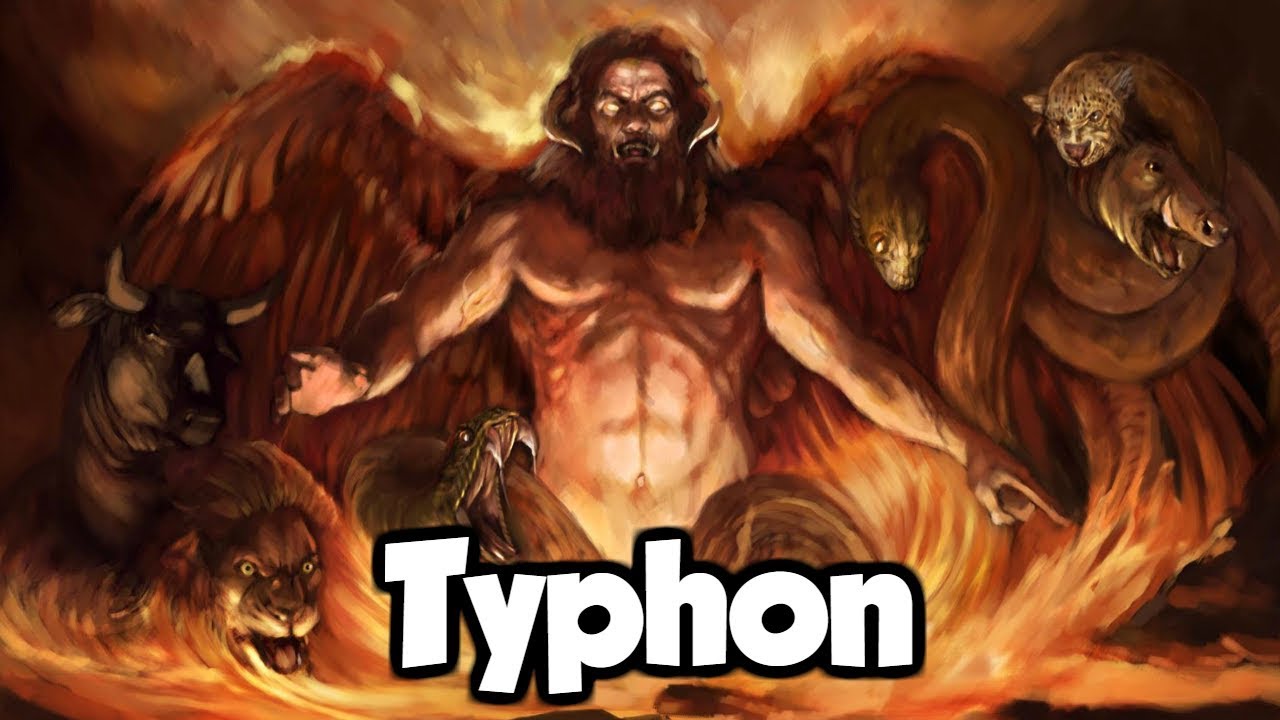Today we explore the fearsome monster of Greek mythology known as Typhon, the father of all monsters. The battle between the Titans and the Olympians was in full swing, and Gaia, the primordial goddess of the Earth, could not bear to see her children defeated. In a final attempt to repel Zeus and the Olympians, Gaia and Tartarus created Typhon, a monstrous creature with the body of a man and the lower body made up of giant vipers. Towering as tall as the sky with wings and glowing red eyes, Typhon wreaked havoc wherever he went, breathing fire and causing devastation. Despite many of the Olympians fleeing in fear, Zeus stood firm and engaged in a series of battles with Typhon. Eventually, Zeus overpowered Typhon and cast him into the bottomless pits of Tartarus, placing a mountain over him to prevent escape. Typhon is often referred to as the father of monsters, as he and his wife Echidna birthed iconic creatures such as the Nemean Lion, Cerberus, Hydra, and the Chimera. This battle marked a pivotal moment in Greek mythology, symbolizing the end of the war between the old gods and the rise of the new.
The Creation of Typhon
Gaia and Tartarus create Typhon to repel Zeus and the Olympians
In Greek mythology, Typhon is a formidable monster who was created by Gaia, the Earth, and Tartarus, the primordial deity of the dark underworld. Gaia and Tartarus joined forces to bring Typhon into existence, with the specific purpose of using him to repel Zeus and the Olympian gods. As the powerful ruler of the Titans, Zeus posed a threat to Gaia and Tartarus, and they saw Typhon as their ultimate weapon to thwart the rising power of the Olympians.
Description of Typhon
Various depictions of Typhon’s appearance
Described as the most fearsome and monstrous creature in Greek mythology, Typhon is portrayed in several different ways throughout ancient texts and artistic representations. Some accounts depict him as a massive, fire-breathing, serpent-like creature, with a hundred dragon heads sprouting from his neck. Others describe him as a creature with the lower body of a serpent and the upper body of a man, adorned with a multitude of wings and serpentine appendages. Regardless of the variations in his physical appearance, one consistent element is that Typhon is always depicted as an immensely powerful and terrifying being.

Typhon’s Battle with the Olympians
Zeus stands firm against Typhon
Zeus overpowers Typhon with the help of Hermes
Typhon is cast into Tartarus
When Typhon was unleashed upon the Olympians, chaos ensued. His immense size and strength made him a formidable opponent for the gods, causing widespread panic among their ranks. However, Zeus, the king of the gods, stood firm against Typhon, refusing to be intimidated by his ferocity. In an epic battle of titanic proportions, Zeus engaged Typhon in a fierce struggle. With his thunderbolts and lightning, Zeus fought valiantly, unleashing his full power to quell the menace of Typhon.
Knowing that he needed more than just his own strength to defeat such a formidable adversary, Zeus sought the aid of Hermes, the messenger of the gods. With his cunning and agility, Hermes was able to outmaneuver Typhon and deliver a powerful blow that weakened him. Seizing the opportunity, Zeus seized Typhon and cast him into Tartarus, the deepest and darkest abyss of the underworld, where he would be imprisoned for eternity.
Mount Etna: Typhon’s Prison
Zeus places Mount Etna over Typhon’s prison
Belief that volcanic eruptions and earthquakes are caused by Typhon
To ensure that Typhon would never escape his imprisonment in Tartarus, Zeus placed Mount Etna, a colossal volcano, over his prison. As the highest active volcano in Europe, Mount Etna was believed to be the physical embodiment of Typhon’s prison. The eruptions and earthquakes that occurred around the mountain were seen as manifestations of Typhon’s relentless attempts to break free. This belief in the connection between volcanic activity and Typhon’s wrath added a mysterious and awe-inspiring dimension to the already fearsome reputation of the monster.
Typhon: The Father of Monsters
Typhon and Echidna create various monstrous creatures
Monsters such as the Nemean Lion, Cerberus, and Sphinx are children of Typhon and Echidna
In addition to his role as a fearsome opponent of the Olympians, Typhon also played a significant part in the creation of various monstrous creatures. Typhon and his mate Echidna, herself a half-woman, half-serpent creature, gave birth to a brood of terrifying monsters. Among their monstrous offspring were the Nemean Lion, a creature with impenetrable skin; Cerberus, the three-headed guardian of the underworld; and the Sphinx, a creature with the head of a human and the body of a lion. These monstrous beings added depth and complexity to Greek mythology, demonstrating the wide range of creatures that inhabited the ancient Greek world.
Symbolism and Significance of Typhon
Typhon marks the end of the war between the Olympians and Titans
Typhon represents the destructive force of chaos and the rise of the new generation of gods
Typhon’s significance in Greek mythology goes beyond his role as a terrifying and powerful monster. His creation and subsequent defeat mark a crucial transition in Greek mythology, symbolizing the end of the war between the older generation of gods, known as the Titans, and the rising power of the Olympians. With Typhon’s defeat, Zeus and his siblings solidified their dominance, establishing themselves as the ruling pantheon. Typhon represents the destructive force of chaos, challenging the order and stability brought by the Olympians. His defeat signifies the triumph of the new generation of gods and the progression of the Greek pantheon.
Conclusion
Typhon is a symbol of evil and destruction in Greek mythology
His creation of monsters adds depth to Greek mythology
Typhon’s defeat signifies the triumph of the Olympians and the progression of the Greek pantheon
In Greek mythology, Typhon stands as a symbol of evil and destruction. As a monstrous creature unleashed upon the Olympians, he embodies the menacing and chaotic forces that the gods must overcome to maintain order and stability. Additionally, his role in creating monstrous offspring adds depth and complexity to the realm of Greek mythology, showcasing the diverse range of creatures that populate ancient Greek stories.
However, despite Typhon’s terrifying presence, his defeat by Zeus symbolizes the triumph of the Olympian gods. It represents the progression of the Greek pantheon, the shift from the old order to the new, and the establishment of Zeus and his siblings as the ruling deities. Typhon’s story serves as a reminder of the eternal struggle between order and chaos, good and evil, and the constant evolution and development of mythological traditions.
